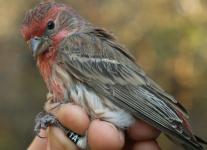|
In November 2011, McGill Bird Observatory (MBO) launched the Feeder Bird Study, an attempt to learn more about the local winter movements of common backyard bird species. In the first phase of the study, the focal species are American Goldfinch and House Finch; all individuals banded at MBO in winter receive a black band with a unique two-character code that can be read from a moderate distance with binoculars (or using the zoom on a digital camera). Public participation is critical to the success of this project - with your help, we can document the areas frequented by particular individuals and explore whether patterns of movement differ by age or sex in the species we are studying.
 |
A House Finch from our study wearing a colour band (left), and a closer view of the band (right). |
|
Background:
Although both American Goldfinches and House Finches are present year-round in the Montreal area, banding results at MBO suggest that these species may not be as resident as they appear at first glance. Between 2004 and 2010, 1157 American Goldfinches and 189 House Finches were banded at MBO, but the rate of recapture of both species has been much lower than expected, especially during winter when there appears to be a surprising amount of turnover in the flocks frequenting our feeders.
Objectives:
The primary aim of the Feeder Bird Study is to learn about the local movements of common urban bird species. By compiling sightings of uniquely marked individuals, we hope to be able to describe the extent of territories, and compare whether these vary by species, age or sex, and also how patterns of occurrence differ by season. A better understanding of these local movements may help with refining population estimates and the extent to which these species may actually be migratory.
Methods:
The Winter Bird Monitoring Program at MBO spans the period from October 31 to March 27. During this period, volunteers maintain a set of feeders on site, with seed generously donated by CCFA Nature Expert. Banding occurs periodically throughout the season, although limited to milder periods of weather. All birds banded receive a standard aluminum band, while American Goldfinches and House Finches also get a colour band on the other leg. For the winter of 2011-2012, this is a black band with two white alphanumeric characters.
How to help:
MBO volunteers track sightings of all marked birds that return to the feeders on site, but more critical to the success of this program is knowing where these individuals go once they leave MBO. If you see a colour-banded finch at your own feeders or elsewhere, please use our reporting page to provide us details on your observation. Although we expect that the majority of sightings will occur in Montreal and surrounding areas, we suspect some individuals will range over great distances, so we welcome reports from anywhere. You can also support the project by "adopting" one or more of our marked birds - click here for more details.
Results:
We will include brief interim updates on the project in our monthly reports on the Winter Bird Monitoring Program, which can be accessed from our banding log (a link to our most recent report is also featured on the MBO home page). A more complete summary will be included each year in our MBO Annual Research Report, and upon completion of the project, a dedicated report on the Feeder Bird Study will be prepared.
|
|